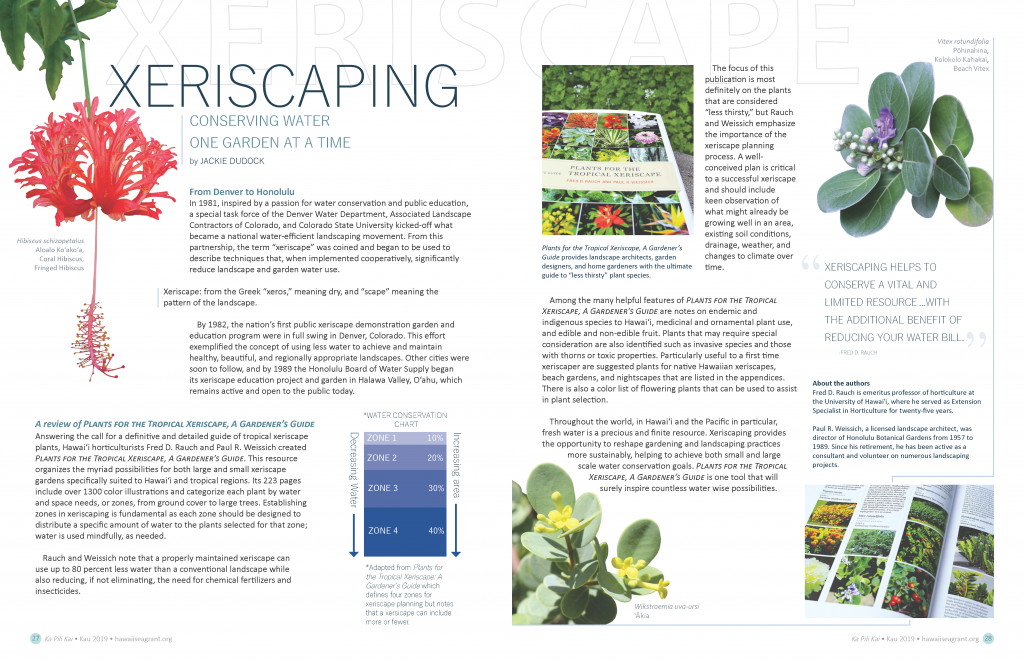From Denver to Honolulu
In 1981, inspired by a passion for water conservation and public education, a special task force of the Denver Water Department, Associated Landscape Contractors of Colorado, and Colorado State University kicked-off what became a national water-efficient landscaping movement. From this partnership, the term “xeriscape” was coined and began to be used to describe techniques that, when implemented cooperatively, significantly reduce landscape and garden water use.
Xeriscape: from the Greek “xeros,” meaning dry, and “scape” meaning the pattern of the landscape.
By 1982, the nation’s first public xeriscape demonstration garden and education program were in full swing in Denver, Colorado. This effort exemplified the concept of using less water to achieve and maintain healthy, beautiful, and regionally appropriate landscapes. Other cities were soon to follow, and by 1989 the Honolulu Board of Water Supply began its xeriscape education project and garden in Halawa Valley, O‘ahu, which remains active and open to the public today.
A Review of Plants for the Tropical Xeriscape, A Gardener’s Guide
Answering the call for a definitive and detailed guide of tropical xeriscape plants, Hawai‘i horticulturists Fred D. Rauch and Paul R. Weissich created Plants for the Tropical Xeriscape, A Gardener’s Guide. This resource organizes the myriad possibilities for both large and small xeriscape gardens specifically suited to Hawai‘i and tropical regions. Its 223 pages include over 1300 color illustrations and categorize each plant by water and space needs, or zones, from ground cover to large trees. Establishing zones in xeriscaping is fundamental as each zone should be designed to distribute a specific amount of water to the plants selected for that zone; water is used mindfully, as needed.
Rauch and Weissich note that a properly maintained xeriscape can use up to 80 percent less water than a conventional landscape while also reducing, if not eliminating, the need for chemical fertilizers and insecticides.
The focus of this publication is most definitely on the plants that are considered “less thirsty,” but Rauch and Weissich emphasize the importance of the xeriscape planning process. A well-conceived plan is critical to a successful xeriscape and should include keen observation of what might already be growing well in an area, existing soil conditions, drainage, weather, and changes to climate over time.
Among the many helpful features of Plants for the Tropical Xeriscape, A Gardener’s Guide are notes on endemic and indigenous species to Hawai‘i, medicinal and ornamental plant use, and edible and non-edible fruit. Plants that may require special consideration are also identified such as invasive species and those with thorns or toxic properties. Particularly useful to a first time xeriscaper are suggested plants for native Hawaiian xeriscapes, beach gardens, and nightscapes that are listed in the appendices. There is also a color list of flowering plants that can be used to assist in plant selection.
Throughout the world, in Hawai‘i and the Pacific in particular, fresh water is a precious and finite resource. Xeriscaping provides the opportunity to reshape gardening and landscaping practices more sustainably, helping to achieve both small and large scale water conservation goals. Plants for the Tropical Xeriscape, A Gardener’s Guide is one tool that will surely inspire countless water wise possibilities.
About the authors
Fred D. Rauch is emeritus professor of horticulture at the University of Hawai’i, where he served as Extension Specialist in Horticulture for twenty-five years.
Paul R. Weissich, a licensed landscape architect, was director of Honolulu Botanical Gardens from 1957 to 1989. Since his retirement, he has been active as a consultant and volunteer on numerous landscaping projects.
Browse Ka Pili Kai issues HERE


